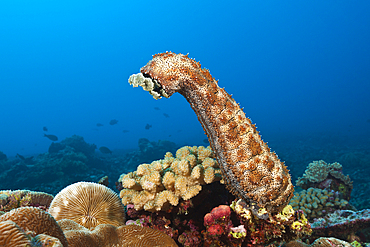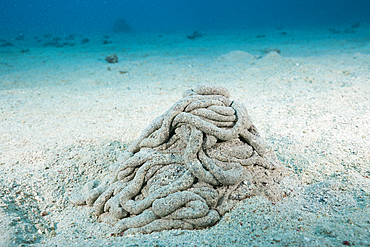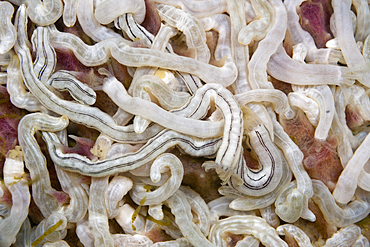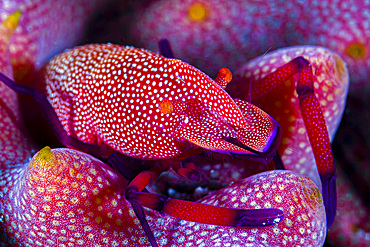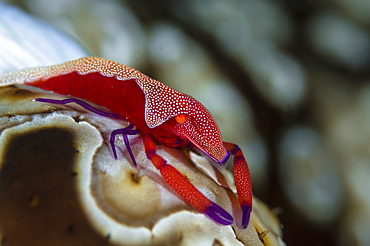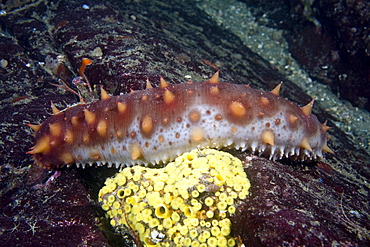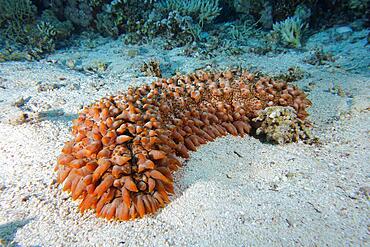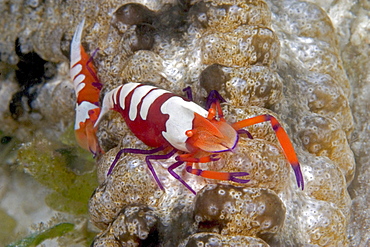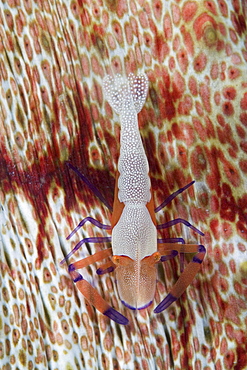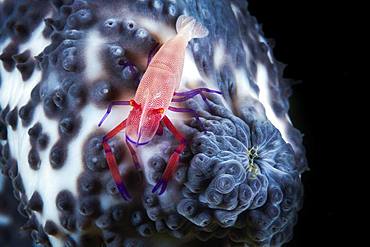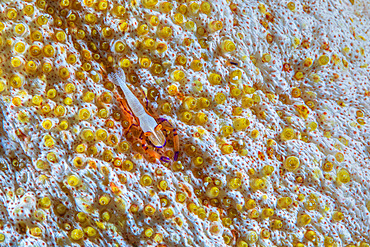Results
13 results found
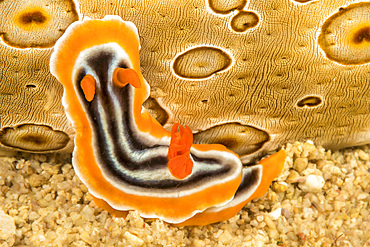
A pajama nudibranch (Chromodoris quadricolor) attempts to climb up the side of a sea cucumber, Philippines, Southeast Asia, Asia
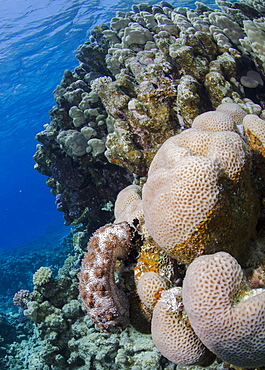
Blackmouth sea cucumber (Pearsonothuria graeffei) on coral reef, Ras Mohammed National Park, Sharm Eel-Sheikh, Red Sea, Egypt, North Africa, Africa

Sea cucumber (Bohadschia graeffei), and scuba diver SouthernThailand, Andaman Sea, Indian Ocean, Southeast Asia, Asia

Vibrant sea cucumbers, tunicates, hydroids, and other invertebrates cling to a reef in Raja Ampat, Indonesia.
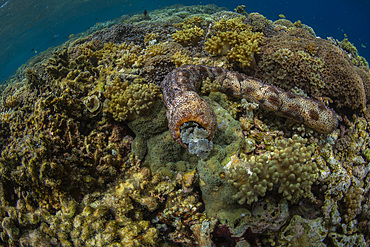
Graeffe's sea cucumber (Pearsonothuria graeffe), in the shallow reefs off Sandy Beach, Manta Point, Raja Ampat, Indonesia, Southeast Asia, Asia

Sea cucumbers (Synaptula sp.) on giant barrel sponge (Xestospongia testudinaria), Dumaguete, Negros Island, Philippines, Southeast Asia, Asia

Dried shark fins and sea cucumbers for sale in traditional chinese medicine store, Hong Kong, China, Asia

Emperor shrimp (Periclimenes imperator) on synaptid sea cucumber, Masaplod, Negros, Philippines, Southeast Asia, Asia
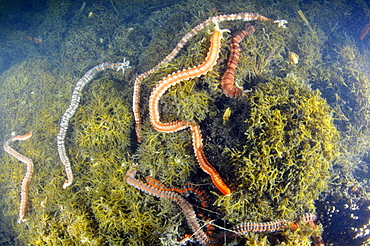
Cluster of sea cucumbers (Ophiodesoma spectabilis), Kaneohe Bay, Oahu, Hawaii, United States of America, Pacific

Sea cucumber (Bohadschia argus) skin detail, Pohnpei, Federated States of Micronesia, Caroline Islands, Micronesia, Pacific Ocean, Pacific

Sea cucumber (Holothuria sp.), anus detail, Puerto Galera, Mindoro, Philippines, Southeast Asia, Asia

Sea cucumber (Bohadschia argus) skin detail, Pohnpei, Federated States of Micronesia, Caroline Islands, Micronesia, Pacific Ocean, Pacific

Emperor shrimp (Periclimenes imperator) on synaptid sea cucumber, Masaplod, Negros, Philippines, Southeast Asia, Asia

Sea cucumbers (Synaptula sp.) on giant barrel sponge (Xestospongia testudinaria), Dumaguete, Negros Island, Philippines, Southeast Asia, Asia
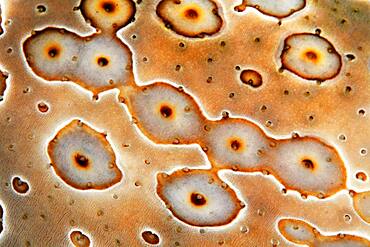
Detail of Eye patch sea cucumber (Bohadschia argus), Pacific, Great Barrier Reef, Australia, Oceania
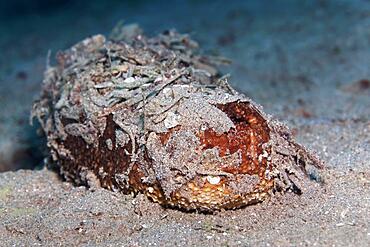
Sea cucumber also sea cucumber or holothuria (Holothuria) camouflaged with seaweed, Red Sea, Aqaba, Kingdom of Jordan
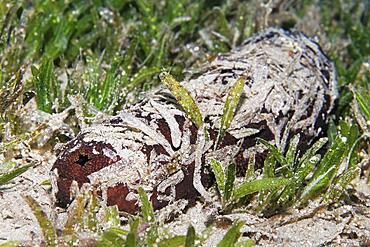
Sea cucumber also sea cucumber or holothuria (Holothuria) camouflaged with seaweed, Red Sea, Aqaba, Kingdom of Jordan
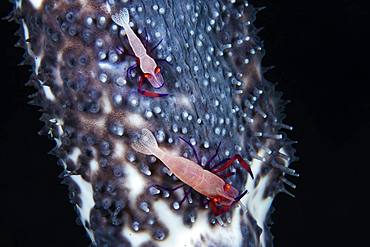
Couple of Imperial Shrimp (Periclimenes imperator) on a blue sea cucumber (Actinopyga caerulea) 76 meters deep, Mayotte
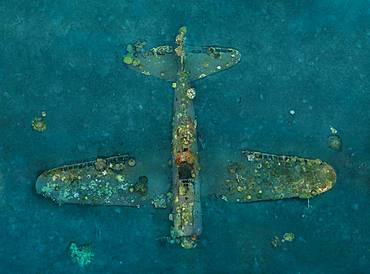
Tara Pacific expedition - november 2017 Zero wreck, vertical view Orthomosaic from 3D photogrammetry (13500 x 10000 px). D: 15 m Kimbe Bay, papua New Guinea, Coral growth on this wreck is from a period of 74 years ! The ZERO, is a Japanese WW2 fighter plane wreck. This Zero wreck was discovered in January 2000 by local William Nuli while he was freediving for sea cucumbers. He asked the Walindi Plantation Resort dive team if they might know what it was, and when they investigated they uncovered the intact wreck of a Zero fighter, resting on a sedimented bottom in 15 m depth. This World War II Japanese fighter is almost completely intact. The plane is believed to have been ditched, the pilot is believed to have survived, but was never found on the island. He never returned home. Maybe he disappeared in the jungle? On 26th December 1943, during the battle of Cape Gloucester, the Japanese pilot made an emergency landing, ditching his Mitsubishi A6M Zero plane into the sea approximately 100m off West New Britain Province. The plane was piloted by PO1 Tomiharu Honda of the 204st K?k?tai. His fate is unknown but it is believed the he made a controlled water landing after running out of fuel and survived. Although he failed to return to his unit, the plane was found with the throttle and trim controls both set for landing and the canopy was open. There are no visible bullet holes or other shrapnel damage and the plane is still virtually intact after over 70 years underwater. It is a A6M2 Model 21 Zero, made famous for its use in Kamikaze attacks by the Japanese Imperial Navy. The wreck has the Manufacture Number 8224 and was built by Nakajima in late August 1942.

Tara Pacific expedition - november 2017 Kimbe Bay, papua New Guinea, Zero wreck: Coral growth on this wreck is from a period of 74 years ! D: 15 m The ZERO, is a Japanese WW2 fighter plane wreck. This Zero wreck was discovered in January 2000 by local William Nuli while he was freediving for sea cucumbers. He asked the Walindi Plantation Resort dive team if they might know what it was, and when they investigated they uncovered the intact wreck of a Zero fighter, resting on a sedimented bottom in 15 m depth. This World War II Japanese fighter is almost completely intact. The plane is believed to have been ditched, the pilot is believed to have survived, but was never found on the island. He never returned home. Maybe he disappeared in the jungle? On 26th December 1943, during the battle of Cape Gloucester, the Japanese pilot made an emergency landing, ditching his Mitsubishi A6M Zero plane into the sea approximately 100m off West New Britain Province. The plane was piloted by PO1 Tomiharu Honda of the 204st K?k?tai. His fate is unknown but it is believed the he made a controlled water landing after running out of fuel and survived. Although he failed to return to his unit, the plane was found with the throttle and trim controls both set for landing and the canopy was open. There are no visible bullet holes or other shrapnel damage and the plane is still virtually intact after over 70 years underwater. It is a A6M2 Model 21 Zero, made famous for its use in Kamikaze attacks by the Japanese Imperial Navy. The wreck has the Manufacture Number 8224 and was built by Nakajima in late August 1942.
